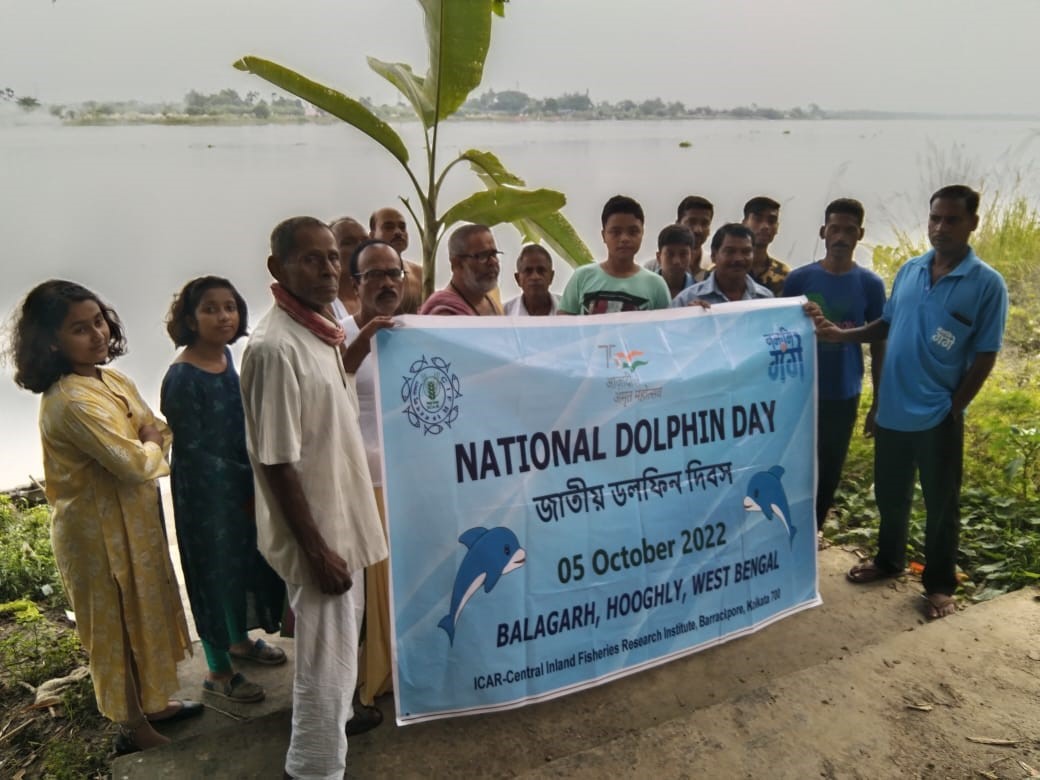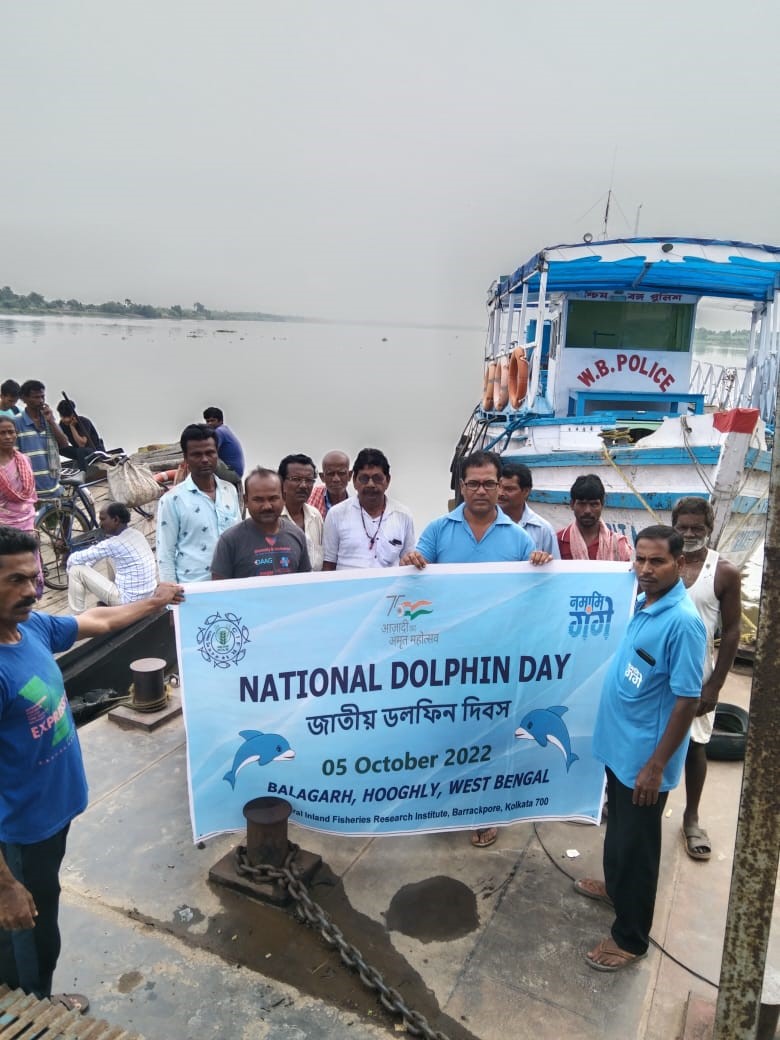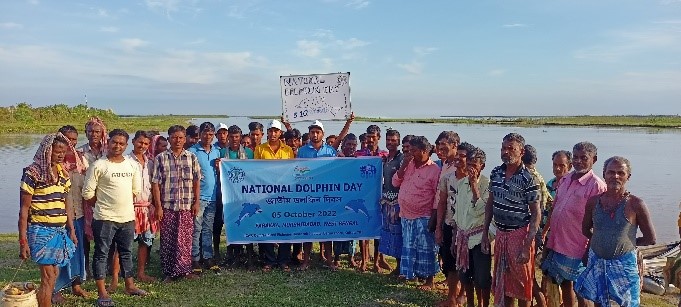Overview
Publications
Recruitment
Intranet
CIFRI Corners'
Healthy aquatic environments contribute to the planet's overall well-being. Dolphin conservation would therefore help ensure the survival of the species and the humans who depend on the aquatic ecosystem for their way of life. Dolphins are the ideal ecological markers of a healthy aquatic ecosystem. On August 15, 2020, the “Project Dolphin” was launched by the honourable Prime Minister Narendra Modi to include both river dolphins and marine dolphins in its conservation program. Because of the significance of dolphins, Environment Minister Bhupendra Yadav declared October 5th “National Dolphin Day”, to be observed annually to raise awareness for dolphin conservation. He announced while presiding over the 67th meeting of the Standing Committee of the National Board for Wildlife in New Delhi.
 To mark the day a significantly remarkable one, ICAR-Central Inland Fisheries Research Institute commemorated ‘National Dolphin Day’ on 5th October 2022 at four different places namely Farakka, Nabadwip, Tribeni, and Balagarh on the bank of river Ganga under Namami Gange Program. On this occasion, more than 200 personnel including active fishers, social activities, and students residing on the banks of the river participated and were aware of the day.
To mark the day a significantly remarkable one, ICAR-Central Inland Fisheries Research Institute commemorated ‘National Dolphin Day’ on 5th October 2022 at four different places namely Farakka, Nabadwip, Tribeni, and Balagarh on the bank of river Ganga under Namami Gange Program. On this occasion, more than 200 personnel including active fishers, social activities, and students residing on the banks of the river participated and were aware of the day.  Dr. Basanta Kumar Das, Director of ICAR-CIFRI and Principal Investigator of the NMCG project, informed us in the conveying message that India's waters are home to about 30 species of marine mammals, including river dolphins. The Gangetic River dolphin (Platanista gangetica) lives only in the Ganga-Brahmaputra systems, while the Indus River dolphin (Platanista minor) is only found in the Indus system, which includes the Sutlej, Ravi, and Beas rivers. He also emphasised the Gangetic dolphin's importance as an indicator species for the Ganga ecosystem, whose vulnerability to changes in water quality and flow offers information on the general condition of the ecosystem and other species in that ecosystem. The International Union for Conservation of Nature's Red List lists it as endangered.
Dr. Basanta Kumar Das, Director of ICAR-CIFRI and Principal Investigator of the NMCG project, informed us in the conveying message that India's waters are home to about 30 species of marine mammals, including river dolphins. The Gangetic River dolphin (Platanista gangetica) lives only in the Ganga-Brahmaputra systems, while the Indus River dolphin (Platanista minor) is only found in the Indus system, which includes the Sutlej, Ravi, and Beas rivers. He also emphasised the Gangetic dolphin's importance as an indicator species for the Ganga ecosystem, whose vulnerability to changes in water quality and flow offers information on the general condition of the ecosystem and other species in that ecosystem. The International Union for Conservation of Nature's Red List lists it as endangered. Recent data (2017-18) shows that the estimated Ganges River dolphin in the Ganga River basin, along with tributaries, stands around 2644, and in the Brahmaputra, along with its tributaries, stands at 987. “Due to multiple threats, including pollution, water diversion, habitat fragmentation, and bycatch, the Ganges River dolphin is seriously threatened.
Dolphins in India face numerous challenges, so spreading knowledge about them is crucial, said Dr. Dibakar Bhakta, an institute scientist who coordinating the programs. Locals have been made aware of various river conservation measures through the awareness and sensitization programme, such as refraining from using pesticides on agricultural and horticultural lands along the river, reforestation of the riverbank to prevent bank erosion, refraining from discarding plastic and other trash in the river, releasing enough water from dams and barrages, maintaining riverine biodiversity using scientific fishing gears, and more. This is the stated goal of the recently established "National Dolphin Day."
Recent data (2017-18) shows that the estimated Ganges River dolphin in the Ganga River basin, along with tributaries, stands around 2644, and in the Brahmaputra, along with its tributaries, stands at 987. “Due to multiple threats, including pollution, water diversion, habitat fragmentation, and bycatch, the Ganges River dolphin is seriously threatened.
Dolphins in India face numerous challenges, so spreading knowledge about them is crucial, said Dr. Dibakar Bhakta, an institute scientist who coordinating the programs. Locals have been made aware of various river conservation measures through the awareness and sensitization programme, such as refraining from using pesticides on agricultural and horticultural lands along the river, reforestation of the riverbank to prevent bank erosion, refraining from discarding plastic and other trash in the river, releasing enough water from dams and barrages, maintaining riverine biodiversity using scientific fishing gears, and more. This is the stated goal of the recently established "National Dolphin Day." 









